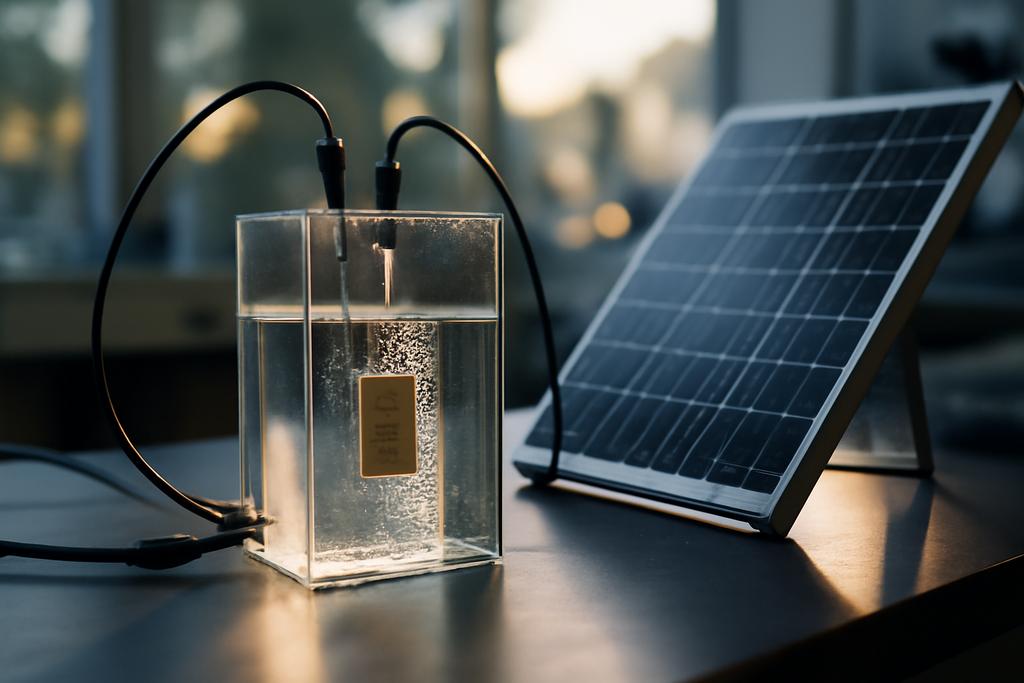Unlocking the Secrets of Water Splitting: A Generative AI Approach
Imagine a world powered by abundant, clean hydrogen, a fuel that could revolutionize everything from transportation to industry. The key to this future lies in efficient, scalable photocatalytic water splitting (PWS) — the process of using sunlight to break water molecules into hydrogen and oxygen. This is a holy grail of sustainable energy, and now, researchers at Southeast University, led by Qionghua Zhou and Jinlan Wang, have made a remarkable leap forward by using AI to design materials that dramatically improve this crucial process.
For decades, discovering new materials with the precise properties needed for PWS has been painstakingly slow. Traditional methods rely on trial and error, sifting through countless possibilities. It’s like searching for a specific grain of sand on a vast beach using only a spoon. But what if you could design the beach itself, creating a landscape more conducive to finding that precious grain? That’s the power of this new approach.
Beyond Trial and Error: The Power of Generative AI
The researchers developed SSAGEN (Stability and Symmetry-Assured GENerative framework), a groundbreaking AI system. Instead of merely analyzing existing materials, SSAGEN *generates* entirely new ones with pre-defined properties. This is inverse design, akin to sculpting a statue by starting with its desired form, rather than chipping away at a block of marble. The system works in two stages.
First, SSAGEN designs the fundamental building blocks of a crystal structure, including its lattice, composition, and space group (its symmetry). Think of this as designing the blueprints for a house, specifying the overall shape, materials, and architectural style. Then, the AI optimizes the atomic positions within this structure, ensuring it’s both stable and suitable for PWS. This is like carefully arranging the bricks and mortar to build a strong, functional house.
What makes SSAGEN stand out is its ability to ensure the resulting structures are stable and symmetrical. Many previous AI methods struggled with this, producing materials that were theoretically interesting but unstable in the real world—like a beautiful architectural design that collapses under its own weight. SSAGEN elegantly solves this, dramatically increasing the success rate of producing usable PWS materials.
A Quantum Leap in Efficiency
The results are staggering. SSAGEN generated 200,000 structures, a huge number, and 81.2% of them were completely novel, meaning they didn’t exist in any known database. It’s like suddenly discovering a whole new continent filled with undiscovered treasures. More significantly, 3,318 of these met all the stability and energy criteria necessary for PWS, a 15-fold improvement over existing methods.
Even more impressive, 95.6% of these candidates were confirmed by rigorous density functional theory (DFT) calculations, a highly accurate computational method. This high validation rate demonstrates the power and precision of the AI. The team even identified 24 optimal candidates, paving the way for experimental verification and potential real-world applications.
The Broader Implications: A New Era of Materials Discovery
The implications of SSAGEN extend far beyond water splitting. Its modular and general design makes it applicable to other functional materials. It is a truly versatile tool, adaptable to a wide range of applications. Imagine discovering revolutionary materials for batteries, semiconductors, or even medicine – the possibilities are vast.
SSAGEN represents a significant paradigm shift in materials discovery. It moves us from a process of painstaking trial and error to a more automated, efficient, and predictable system. This isn’t just about creating better materials; it’s about accelerating the pace of innovation across numerous scientific and technological domains. It accelerates the process, allowing scientists to make significant advances faster and more efficiently. This has the potential to significantly impact multiple industries, including renewable energy, electronics, and medicine.
The researchers’ work signifies a notable advancement in materials science. Their innovative approach, using AI to design and optimize materials for water splitting, showcases the immense potential of integrating artificial intelligence with experimental research. This approach may lead to the creation of more efficient and cost-effective materials, thereby contributing to the development of sustainable energy solutions.
Beyond the Lab: Real-World Applications
While still in its early stages, SSAGEN’s potential real-world impact is immense. The ability to design stable, high-performing materials for PWS could drastically reduce the cost and complexity of hydrogen production, paving the way for widespread adoption of this crucial clean energy source.
The implications ripple outwards, touching upon various aspects of our lives. From cleaner transportation to more sustainable industrial processes, the impact of this innovation could be transformative. It’s a testament to the power of interdisciplinary collaboration, combining materials science, computational chemistry, and the rapidly advancing field of artificial intelligence.
The work from Southeast University highlights how AI can help solve some of humanity’s most pressing challenges. SSAGEN offers a glimpse into a future where technological innovation drives us towards a cleaner, more sustainable world. And that’s a future worth striving for.










